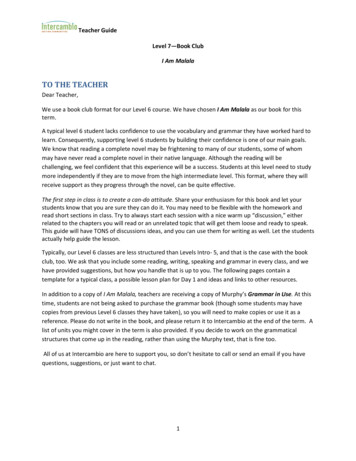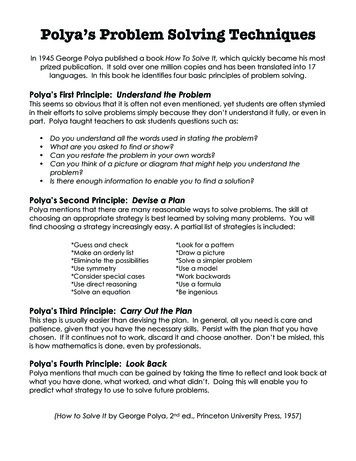
Transcription
TEACHER BACKGROUND:EARTH’S ATMOSPHEREThe atmosphere is the thin envelope of gas molecules surrounding theEarth; it is held down by Earth’sgravitational pull. The atmosphere isconcentrated at the Earth’s surface andrapidly thins as you move upward,blending with space at about 100 milesabove sea level. The atmosphere isactually very thin compared to the sizeof the earth. Its thickness can becompared to a piece of paper laid over abeach ball or the skin of an apple. Theheat trapping ability it has helps to keepthe Earth warm enough for life, and italso protects the Earth from harmful solar radiation and cosmic rays.Layers of the AtmosphereWhile there are no exact boundarieswithin the atmosphere, it is dividedinto layers based on temperature andpressure. The very lowest layer,which contains 90% of theatmosphere's mass, is called thetroposphere. This is also where allliving things are found and where allweather occurs. Airplanes fly at thevery top of the troposphere, so theycan fly over the weather, whichcauses turbulence. The jet stream, afast moving region of wind in theupper troposphere has been clockedat over 300 miles per hour! Whiletemperatures at the bottom of the troposphere are nice and hospitable forlife, temperatures at the top about -60 F! The troposphere is also thethinnest layer, only about 10 miles high.1
The second layer up from the ground is the stratosphere. This layer extendsfrom about 10-30 miles, and unlike the troposphere, it increases intemperature with elevation. It starts out from about -60 F at the bottom toabout 32 F, at the top). This is because ozone molecules form here and absorbthe warm ultraviolet radiation from the sun.The third and middle layer is the mesosphere. This layer extends from 30-50miles in altitude, and unlike the stratosphere below, it absorbs very littlesolar radiation. This layer is incredibly cold, going from freezing at thebottom to about -130 F at the top.The next layer up, the thermosphere, is the largest layer, extending from50-300 miles. Satellites orbit Earth here, and this layer actually increases intemperature with increasing altitude. The ionosphere is a sub-layer found atthe top of the mesosphere and the bottom of the thermosphere and gets itbecause it is ion-rich. This region is a special place in the sky because this iswhere displays of light in the sky called auroras occur.The final layer is the called the exosphere because it is on the outside like anexoskeleton. This layer begins at about 300 miles from the ground but, asmentioned before, slowly fades into space, so it's hard to tell exactly whereit ends.Origin of the AtmosphereScientists believe that Earth wasformed about 5 billion years ago. Inthe first, 500 million years a denseatmosphere emerged from the vaporand gases expelled during volcanicdegassing of the planet’s interior.These gases probably consisted ofhydrogen (H2), water vapor, methane(CH4), and carbon oxides. Prior to 3.5 billion years ago the atmosphereprobably consisted of carbon dioxide (CO2), water (H2O), nitrogen (N2) andhydrogen. The most important feature of the ancient atmosphere was theabsence of free oxygen. Evidence of an oxygen-free atmosphere is hidden inearly rock formations that contain many elements, such as iron and uranium.2
As the Earth continued to cool, the watervapor found in the atmosphere condensed toform the oceans and fresh water bodies on thecontinents. Early aquatic organisms calledblue-green algae began using energy from thesun to split molecules of H2O (water) and CO2and recombine them into organic compoundsand molecular oxygen (O2). This solar energyconversion process is known as photosynthesis.Without ozone, life could not existon land because of harmfulultraviolet radiation. High in theatmosphere, some oxygen (O2)molecules absorbed energy fromthe Sun’s ultraviolet (UV) rays andsplit to form single oxygen atoms.These atoms combine withremaining oxygen to form “ozone”(O3) molecules, which are veryeffective at absorbing UV rays. The emergence of living organisms wasextremely important in the creation of atmospheric oxygen and ozone.The thin layer of ozone that surroundsEarth acts as a shield, protecting theplanet from irradiation by UV light. UVrays penetrate the atmosphere at threeslightly different wavelengths called UVA, UV-B and UV-C. The ozone layercompletely stops the penetration of UV-Cand most of the UV-B rays. Therefore,the ozone layer protects life on Earthfrom the harmful effects of solarradiation on a daily basis.3
Composition of the Present AtmosphereThe atmosphere is composed of a mix ofseveral different gases in differingamounts. The permanent gases whosepercentages do not change from day to day arenitrogen, oxygen and argon. Nitrogen accountsfor 78% of the atmosphere, oxygen 21% andargon 0.9%. Gases like carbon dioxide, nitrousoxides, methane, and ozone are trace gasesthat account for about a tenth of one percentof the atmosphere. Water vapor is unique- itsconcentration varies from 0-4% of theatmosphere depending on where you are andwhat time of the day it is. In the cold, dryartic regions water vapor usually accounts for less than 1% of theatmosphere, while in humid, tropical regions water vapor can account foralmost 4% of the atmosphere. Water vapor content is very important inpredicting weather.Greenhouse gas percentages vary daily, seasonally, and annually and have physicaland chemical properties that make them act together with solar radiation andinfrared light (heat) given off from the earth to affect the energy balance ofthe planet. This is why scientists are watching the observed increase ingreenhouse gases like carbon dioxide and methane carefully, because even thoughthey are small in amount, they can strongly affect the global energy balance andtemperature over time.Atmospheric CirculationAtmospheric circulation is a major player in the climate of the Earth. The energyand circulation of the atmosphere can be witnessed by regular wind patterns suchas the trade winds. Locally, we experience this mass movement of air molecules asa gentle breeze or the rare extreme of a tornado. The wind motion also transferswater evaporated from the oceans to the continents, providing precipitationcritical to sustain terrestrial ecosystems.4
The pattern of risingmoist air near the equatorand the sinking of dry airin the subtropics isreferred to as HadleyCirculation, a huge part ofthe general circulation ofthe atmosphere. It helpsto transport heat fromthe equatorial regions tohigher latitudes. Becauseof the Hadley circulationthe tropics are warm andwet, while the subtropicsare warm and dry. As aresult of the atmospheric circulation patterns in the higher latitudes, the midlatitudes experience high seasonal contrasts in temperature and rainfall patterns,while the Polar Regions are usually cold and dry. Rainfall in the mid-latitudes iscontrolled in part by the “polar front” or the “storm track.” This expressionrefers to the day-to-day variations in the location and strength of the polarfront.The atmosphere is concentrated at the earth’s surface and rapidly thins asyou move upward, blending with space at roughly 100 miles above sea level. Itis actually very thin compared to the size of the earth, equivalent inthickness to a piece of paper laid over a beach ball. However, it isresponsible for keeping the earth habitable and for producing weather.Atmospheric Temperature and PressureAs Altitude Increases,Air Pressure DecreasesThe atmosphere is held around the Earthby gravity. Gravity pulls gas molecules inthe atmosphere toward the Earth'ssurface, causing air pressure. Air pressureis the measure of the force with which airmolecules push on a surface. Air pressure5
is strongest at the Earth's surface because more air is above you. Asyou move farther away from the Earth's surface, fewer gas moleculesare above you. As altitude (distance from sea level) increases, airpressure decreases.Think of air pressure as a stack of books. The books at the bottomhave all the weight and pressure of the books on top. Air pressureworks in a similar way. People wonder why we are not crushed by airpressure. The reason is that the air pressure is equal in all directions,so air pushes equally on all sides and the forces are balanced.As the air pressure decreases,the density of the atmospherealso decreases. The air particlesare not packed together astightly as the altitude increases,since there is less gravity actingon the gas particles. The air atsea level and at 6km has thesame 21% oxygen, but there arejust fewer molecules taken inwith each breath.The traditional instrument for measuring air pressure was abarometer, which used a glass tubefilled with mercury to register theincreasing and decreasing level in airpressure. However, we now know thatmercury is a very dangerous substanceand is not available for use in thiscapacity any longer. Modernmeasurements are done with a hightech pressure sensor. Theseinstruments use silicon chips and areairtight sealed, stainless steel containers with the pressure sensitivesensor inside.6
Atmospheric Composition Affects Air TemperatureAir temperature also changes as altitude increases. The temperaturedifferences result mainly from the way solar energy is absorbed as itmoves through the atmosphere. Some parts of the atmosphere arewarmer because they contain a high percentage of gases that absorbsolar energy. Other parts of the atmosphere contain less of thesegases and are cooler.The uppermost atmospheric layer is called the thermosphere. Here,temperature again increases with altitude because concentrations ofnitrogen and oxygen are high. Nitrogen and oxygen absorb solarradiation and release thermal energy, which causes temperatures inthe thermosphere to be 1000 C or higher.When most peoplethink of an area thathas high temperatures,they think of a placethat is very hot.Although thethermosphere has veryhigh temperatures, itdoes not feel hot.Temperature isdifferent from heat.Temperature is ameasure of the averageenergy of particles in motion. The high temperature of thethermosphere means that particles in that layer are moving very fast.Heat, however, is the transfer of thermal energy between objects ofdifferent temperatures. Particles must touch one another to transferthermal energy. The space between particles in the thermosphere is sogreat that particles do not transfer much energy. In other words, thedensity of the thermosphere is so low that particles do not oftencollide and transfer energy.7
Think of air pressure as a stack of books. The books at the bottom have all the weight and pressure of the books on top. Air pressure works in a similar way. People wonder why we are not crushed by air pressure. The reason is that the air pressure is equal in all directions, so air











